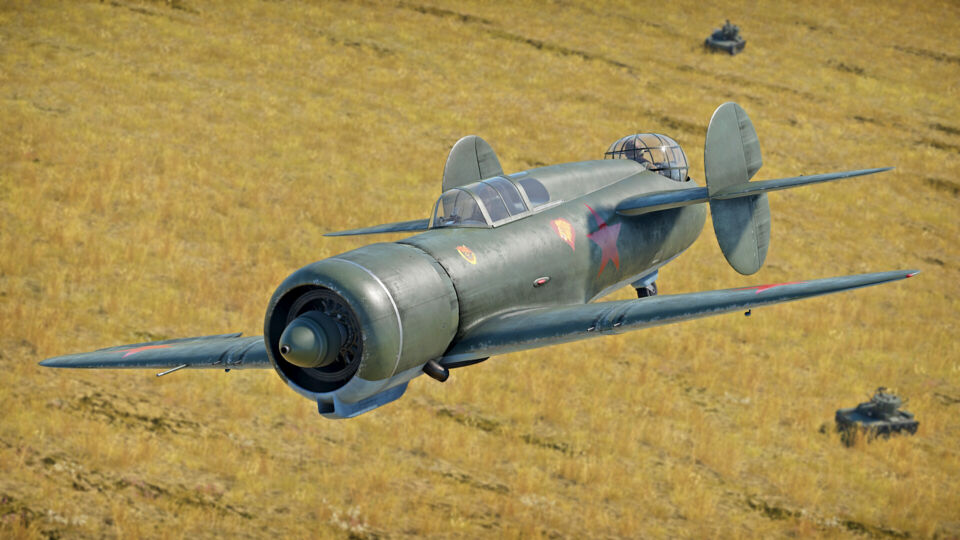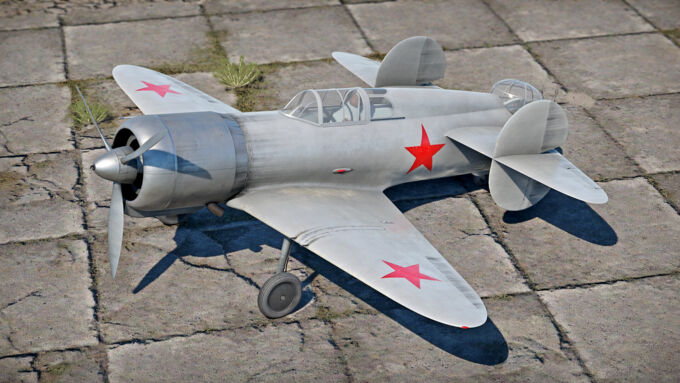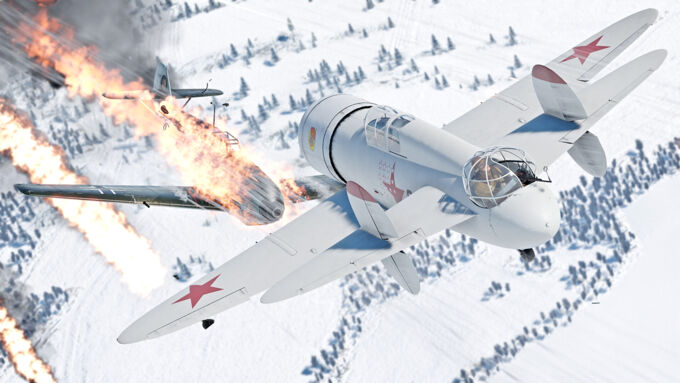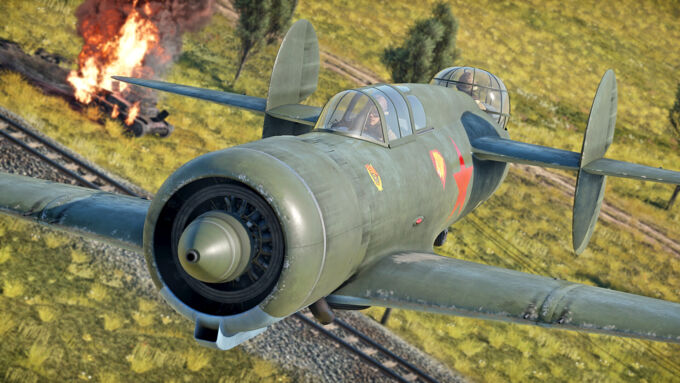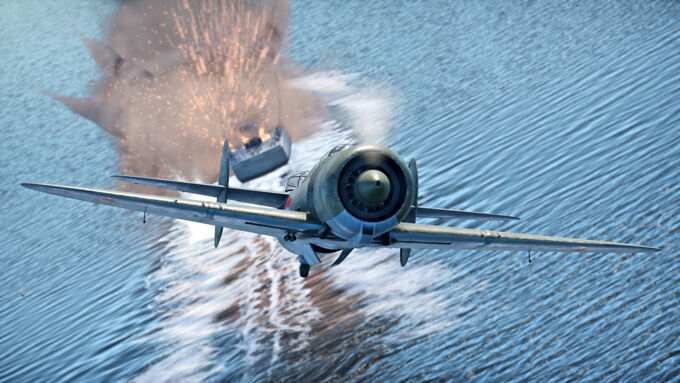Developed back in the 1930s by Pyotr Dmitrievich Grushin, the Tandem-MAI was an experimental Soviet attack aircraft with a really unique tandem wing setup. Mostly built out of wood and without a vertical stabilizer, it was all about being quick on its feet and packing a punch with its weapons. It’s a pretty cool alternative to more traditional ground-attack planes like the Il-2. Even though it never went into mass production, its distinct design and armament make it stand out in War Thunder. Its nimble handling and five fast-firing ShKAS machine guns give players a thrilling, high-stakes experience. Whether slicing through ground targets or dodging enemy fire, the Sh-Tandem delivers a one-of-a-kind combat vibe that’s both wild and fun.
| Pros | Cons |
| Strong forward firing armament | Low bomb load |
| Good speed and manoeuvrability | Weak armour |
| Good firing angles with gunner | Landing gear that breaks at low speeds |
Historical context
The Tandem-MAI, also known as the Sh-Tandem or MAI-3, was an experimental Soviet aircraft developed at the Moscow Aviation Institute in the 1930s. Spearheaded by Pyotr Grushin as part of his October aircraft series, the project aimed to explore the tandem wing layout for improved stability and defensive advantages. Built using readily available materials to facilitate mass production, the aircraft was envisioned as a combat plane capable of reaching speeds between 500 and 530 km/h.
Development began in 1936, but early prototypes faced significant structural and control issues. After extensive refinements, the reinforced prototype was finally test-flown on November 29, 1938. However, pilots found it difficult to handle, struggling with stability in various flight conditions. Despite adjustments to the tail and turret placement, the aircraft failed official state tests. Around that time, the Soviet Defense Committee, influenced by lessons from the battles at Khalkhin Gol and the Spanish Civil War, shifted focus to more conventional attack aircraft. Consequently, the Tandem-MAI project was officially canceled in mid-1939, with only a single prototype ever built. Though abandoned, the Sh-Tandem remains a striking example of the Soviet Union’s willingness to pursue bold, unconventional aviation designs in the years leading up to World War II.
Flight Characteristics
While capable of reaching respectable speeds, the Tandem-MAI struggles against dedicated interceptors like the Bf 109 F-4 or Yak-1B. It lacks the acceleration to recover quickly from poor positioning, meaning every engagement must be carefully planned. Maintaining energy is critical, as any prolonged maneuvering drains its ability to escape or re-engage effectively.
The Sh-Tandem doesn’t really climb as easily as other ground attackers like the Il-2 or certain twin-engine bombers, so rushing straight up isn’t the best move. Instead, it’s smarter to do a side-climb to gain altitude without losing too much speed. Luckily, this plane spawns in the air, so you can start fights already at a decent height—giving you an edge over opponents taking off from the runway. Just bear in mind that keeping your momentum is key, since its unusual design means it trades raw power for being more nimble.
The Tandem-MAI lacks the agility to compete in close-quarters dogfights. Most opponents, from Spitfires to early Yaks, can outturn and outroll it with ease, making sustained engagements a losing proposition. The sluggish roll rate further hampers snap adjustments, forcing pilots to rely on boom-and-zoom tactics—striking decisively and disengaging before the enemy can react.
Survivability
This aircraft’s durability leaves a lot to be desired. With barely any armor to speak of, even a light machine gun shot could take out key parts. The engine’s especially fragile—a simple oil leak could make it break down pretty fast, just like the delicate Bf 109 series.
Defensive capabilities exist, but they are limited. A rear gunner provides some protection, but its effectiveness depends on positioning. Against slow-moving attackers like bombers or sluggish fighters, the gunner might deter pursuit. However, against fast interceptors like the Bf 109 F-4 or La-5FN, survival depends entirely on evasive maneuvers. If pursued, rolling evasively combined with slight altitude changes can make the aircraft harder to hit. Immediate dives into low-altitude terrain—using hills or forests as cover—can force opponents to disengage. Trying to fight directly is a mistake, as prolonged engagements allow enemies with superior energy retention to dictate the fight. If caught in a bad position, a shallow dive into a friendly formation or anti-air cover is often the best escape strategy.
Weaponry
Armed with four 7.62 mm ShKAS machine guns, the Tandem-MAI has a decent forward-facing weapon setup, mounted in the nose for ease of aiming. Unfortunately, its damage output is weak, requiring sustained fire to destroy targets.
Choosing the right ammo really makes a difference in how well it works. The Universal belt is pretty reliable, mixing armor-piercing and incendiary rounds—safe and solid choice. Tracer rounds can help with aiming, but they’re not the kill shots. On the other hand, Stealth belts are perfect for ambushes, but you will need some practice with the weapon system before you get the hang of them.
If you’re using ground attack with the Tandem-MAI, it drops two FAB-100 bombs. They’re not the biggest bombs out there, but if you hit the right spot, they can take out almost any target. Accuracy is essential — since these bombs are small, you really need to be determine precise. Even hefty, well-shielded tanks like the Maus can go down if you strike them just right. A direct hit to weak points—such as the engine deck or ammunition stowage—can be lethal. In skilled hands, the FAB-100s punch far above their weight, rewarding precise targeting over raw explosive mass. The bombs come in pairs, so you have to pick your targets carefully to avoid wasting them. Unlike the Su-2, which carries larger payloads and is a bit more forgiving with its drop patterns, the Tandem-MAI really shines when you nail its precise, surgical strikes.
Gameplay Strategy
Air RB (Realistic Battles)
Effective deployment begins before the first engagement. Instead of climbing steeply, side-climbing provides a better altitude buffer without sacrificing energy. Early-game strategy revolves around hunting bombers and picking off low-energy fighters.
Fighting bombers requires target selection. Since the ShKAS guns lack raw stopping power, the best approach is attacking engines rather than fuselage sections. Light bombers like SB-2Ms and Wellingtons are prime targets, as their weak construction makes them vulnerable.
Dogfights should be avoided unless necessary. Against maneuverable fighters, engaging in turns is a death sentence—the Tandem-MAI will consistently lose to aircraft like Spitfires or Zeros. Instead, it should use boom-and-zoom tactics, making quick dives on distracted enemies before escaping with minimal risk.
Ground attack should be selective. Since its bomb load is minimal, it should prioritize weak targets such as trucks, artillery placements, or AAA positions. Attempting to bomb bases or medium tanks is ineffective and wastes potential damage.
Ground RB (Tank Battles)
Using the Tandem-MAI in Ground RB is largely discouraged, though it isn’t entirely useless. Its bomb load severely limits its damage potential, meaning only light armor or stationary anti-air emplacements should be targeted.
Approaching heavy tanks is pointless—the FAB-100 bombs lack the power to cause meaningful damage. However, precision alone doesn’t guarantee success. Even with bombs placed cleanly on a target’s turret or rear, variables like armor angling, terrain slope, or server desync can cause a solid drop to deal little or no damage. This makes reliability an ever-present challenge, reminding players that even flawless technique can sometimes yield frustrating results. Instead, the aircraft is better suited for eliminating soft ground targets like AAA, as those lack the mobility to evade well-placed bombs.
Its ShKAS machine guns are virtually useless against tanks, meaning engaging ground targets without bombs is a waste of time. Aircraft like the Su-2 family offer far superior bombing capability, with increased payload and better targeting flexibility.
Unlike Ground RB, the Tandem-MAI finds some use in Naval Battles, though careful planning is required.
While its bomb load is light, it remains effective against smaller vessels. Fast attack boats and lightly armored patrol ships can be destroyed with precise bombing runs. However, targeting larger destroyers or cruisers is impractical—the bombs lack penetration, and the aircraft is too fragile to survive AA fire.
Approach angles must be carefully selected. Shallow dives are risky, as shipboard anti-aircraft defenses can shred the Tandem-MAI before it drops its payload. Instead, higher-angle bombing approaches reduce exposure, minimizing damage from AA fire.
Fighter engagement can sometimes be a better alternative to attacking ships. If enemy air cover is weak, focusing on intercepting enemy aircraft can yield better results than risking a bombing run against heavily defended targets.
